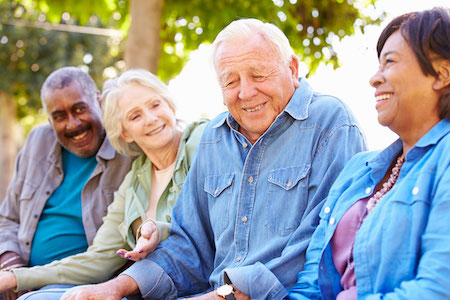Mind – Body – Spirit: Seeking Wellness in Older Adults

Aging as we know it poses many barriers and finding ways to cope with the aging process can be tough. As seniors age and their bodies begin to change, they often experience new challenges that can impact daily living. These physical and cognitive changes in older adults can be accompanied by depression, anxiety, and grief. A way these burdens can be moderated is through the process of seeking wellness. This process of seeking wellness is more than just a single facet to our health, but rather a continuous feat we are striving to achieve on a day in and day out basis.
As defined by the World Health Organization, “Wellness is a state of complete physical, mental, and social well-being, and not merely the absence of disease or infirmity.” Wellness is the act of practicing healthy habits on a daily basis to attain better physical and mental health outcomes. In essence, the goal isn’t to survive, but rather thrive through multidimensional wellness!
Multidimensional Wellness: Why is it Important?
Multidimensional wellness can be seen as various “windows” to achieving wellness. The Six Dimensions of Wellness Model was developed by Dr. Bill Hettler to bring awareness to the interconnectivity of each dimension and how they contribute to healthy living.
Older adults are at high risk for chronic illness, functional decline, and geriatric syndromes. As a result, the need to be more physically, emotionally, spiritually, intellectually, socially, and environmentally healthy is integral for achieving successful aging and independent living.
Six Dimensions of Wellness
- 1. Physical: Encompasses nutrition, sleep, exercise, weight management and other self-care habits to enhance health and prevent disease across the lifespan.
- 2. Social: Connecting and engaging with others and our communities in meaningful ways.
- 3. Intellectual: Engaging the world through learning, problem-solving, and creativity.
- 4. Spiritual: Searching for meaning and higher purpose in human existence.
- 5. Emotional: Being aware of, accepting and expressing our feelings, and understanding the feelings of others.
- 6. Environmental: Fostering positive interrelationships between planetary health and human actions, choices and wellbeing.
Applying Mind – Body – Spirit Connection
Now that you have an idea of what encompasses and contributes to wellness, let’s jump into the various interventions!
- Meditation – Is defined as “the self-regulation of attention.” Seniors can find a wide variety of health benefits in meditation. The practice can reduce the physical symptoms of stress, chronic pain, strengthen your cognitive skills, and improve your mental health.
- Guided Imagery – Recognized by researchers and clinicians as a complementary therapy, encompasses the mind, body, and the spirit used to heal physical and emotional disharmony. This type of intervention utilizes the imaginative capacity of the mind to impact one’s physical, emotional, and spiritual states.
- Tai Chi – A Chinese martial art concentrated on breathing, deliberate movements and meditation. Participants learn to breathe correctly, focusing on how they intake and release air while moving; helping the mind relax and relieve stress. Deep breathing and learning to focus helps improve balance and stability, which can help prevent falls and injuries.
- Yoga – An exercise that cultivates a mind-body connection, combining stretching and strengthening postures with deep breathing and relaxation. Because the poses (called asanas) can easily be modified or adapted to suit an individual’s needs, yoga is safe for seniors of all fitness or ability levels. In fact, it can be an excellent way to keep your body strong and healthy without the joint stress that comes from other activities like weightlifting or jogging.
At St. Paul’s PACE, life enrichment plays a vital role in improving overall health. All of these interventions are appropriate and safe for older adults, but must be cleared through your primary care provider before pursuing.
Achieving Wellness
Our health and longevity is intrinsically linked to the way we think, our emotions, our degree of social connection and our expression of spirituality. Mind – body interventions can be part of your wellness journey and can work in conjunction as a benefit for certain medical and psychological conditions. By engaging in holistic wellness, you can become aware of the interconnectedness of each dimension and how they contribute to healthy living.
St. Paul’s PACE is proud to offer a robust Behavioral Health Program for seniors in San Diego experiencing anxiety, depression, grief, pain or other symptoms. If you, or someone you know, would benefit from St. Paul’s PACE, please contact us at 1-833-PACENOW.
References
McMahon, S., & Fleury, J. (2012). Wellness in older adults: A concept analysis. Nursing forum. Retrieved November, 2022, from https://www.ncbi.nlm.nih.gov/pmc/articles/PMC3326391/
Multidimensional Wellness: Powerful concept and practical tool. Multidimensional Wellness: Powerful Concept and Practical Tool – Wellness, Disease Prevention, And Stress Reduction Information. (n.d.). Retrieved November, 2022, from https://www.mentalhelp.net/blogs/multidimensional-wellness-powerful-concept-and-practical-tool/
Östh, J., Diwan, V., Jirwe, M., Diwan, V., Choudhary, A., Mahadik, V. K., Pascoe, M., & Hallgren, M. (2019, May 29). Effects of yoga on well-being and Healthy Ageing: Study Protocol for a randomized controlled trial (fitforage). BMJ open. Retrieved November, 2022, from https://www.ncbi.nlm.nih.gov/pmc/articles/PMC6549603/
Six Dimensions of Wellness. National Wellness Institute. (2022, February 18). Retrieved November, 2022, from https://nationalwellness.org/resources/six-dimensions-of-wellness/
Wellness for older adults in daily life – Oklahoma State University. Wellness for Older Adults in Daily Life | Oklahoma State University. (2016, October 1). Retrieved November, 2022, from https://extension.okstate.edu/fact-sheets/wellness-for-older-adults-in-daily-life.html
Last updated on June 5th, 2024 at 3:33 am - St. Paul’s PACE website H5629 2102 - Approved on 3/23/2021
